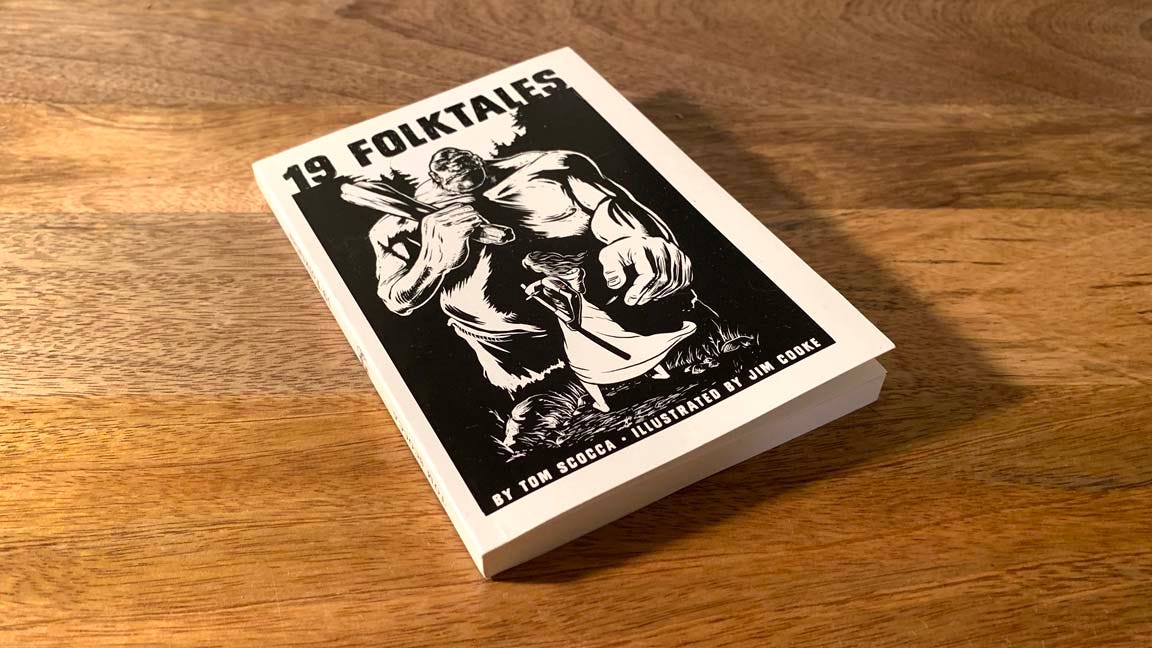Santa's kitchen helper
Indignity Vol. 3. No. 191

BUSINESS DEP'T.

19 Folktales Is Back!
WHEN WE FIRST conceived of making 19 Folktales into a physical book, the underlying idea was always that it could be a holiday present—a compact little volume that would make a nice little gift, or which could fit into a Christmas stocking. Then we kept putting the idea aside and not remembering it until autumn was underway, when it was too late to do anything about it.
To top it off, once we actually did make the book—with the help of the Brick House Cooperative—we managed to sell out our first set of copies right at the beginning of November. However! The second printing is now finished, and the author just lugged the carton of 100 brand-new books up the stairs to the 19 Folktales fulfillment center (aka the Indignity Morning Podcast studio, aka the New York City bureau of the Indignity newsroom).
Twenty copies have been promised to Kickstarter supporters of the Flaming Hydra collaborative publishing venture. The rest are for sale, through Popula.com. U.S. Postal Service media mail delivery takes an estimated 4 to 8 business days, which leaves approximately one week of shopping time before it turns into a gamble against the calendar.
During that week—and afterward, for adrenaline junkies and/or Eastern Orthodox shoppers—the author stands ready to hand-fulfill orders as they come in, even at the cost of dealing with that one clerk at the neighborhood post office whose whole thing is trying to start a fight with everyone who steps up to her window. Happy holidays!

SERVICE JOURNALISM DEP'T.
Indignity Gift Guide: Useful Cooking Gear I Waited Too Long to Own

I LEARNED TO cook with the kitchen equipment that was there at hand—first with what we had around in the kitchen I grew up with, then with the stuff I'd gathered to try to replicate what I grew up with. Gradually, we added more things; gradually, also, the kitchen I'd grown up with also added more things. There were other kitchen gadgets and gear out there, I always knew, but I also knew that a lot of them were pointless and gimmicky: a garlic press isn't worth the hassle of picking scraps of garlic out of the garlic press; a shrimp deveiner is worse than a knife (or, for giant prawns, a surgically inserted toothpick).
Other kitchen gear, however—including incredibly basic, commonsense items it just hadn't occurred to me to bother with—eventually turned out, when I finally got around to using it, to be profoundly helpful and protective, or even indispensable. Some of these items may seem as if no sensible person could possibly cook without them. Nevertheless! I spent a long time in the kitchen without figuring that out. Do not replicate my errors. Look around your kitchen, or the kitchens of your loved ones, see what might be missing, and remedy that with an extremely practical gift.
Kitchen tongs: It's almost impossible to remember what I used to do before I bought tongs. I've had them for years and years, but there were many long years before that when I...did what? Stabbed things with a fork to pick them up or turn them over? Chased them around with a spatula? Tongs are longer, stronger, heatproof fingers, complete with agility and touch. Grab a steak from under the broiler, flip it, and give it a little tap to see if it has the bounce of doneness yet. Pluck steamed shellfish, from hefty lobsters down to fussy little cockles and mussels, out of the hot pan without burning yourself. Poke around in the boiling water where vegetables are blanching, to feel the first touch of softness coming on. Haul spaghetti straight out of the pot and then toss it with the sauce. Get two pairs; you'll end up using them at the same time on different things, or on raw meat and then cooked meat. We have the ones with nylon heads but I'd guess the silicone ones might be even better.
A spider strainer: It's entirely too possible to remember what I used to do before I got a spider: I used to pick up a whole boiling pot of pasta and dump it into a rickety one-handled colander, trying not to tip it over or get any splash burns. Then after dinner it would be time to scrub the starch out of the colander holes. Or, for smaller quantities of items in boiling water, I'd try to fish things out with a crappy slotted spoon. Finally, maybe 15 years ago, I noticed that my parents, who'd taught me the whole colander routine, had started just scooping their penne or rotini out with a spider. It seemed like cheating. You can just do that? Lift out the pasta? And keep the cooking water right there, in case you're making one of those dishes where you mix in the hot cooking water to marry the sauce to the noodles? It also turns out to be essential for handling dumplings, poached eggs, the chicken in chicken soup—anything too small or too numerous to chase down with the tongs. Tidy, efficient, ideal. Also ubiquitous and cheap.
Kitchen shears: We didn't own a real pair of kitchen shears until our first kid started eating solid food, and we suddenly needed to cut lots of things into little bites, quickly. Turns out you constantly need to cut things into little bites, or take pieces off of something that sticks up in space—a whole steamed head of cauliflower, a slow-roasted lamb shank, a lobster tail, a rack of ribs—and the shears let you attack the job with ease. As with the tongs, once you start using one pair, you want a second. We got the kind that come apart for easy cleaning, and they've lasted longer than the hardware store where we got them.
Apron: I was an idiot, OK? I did own an apron, but it was a strapless one that I would only put on in emergencies, because the wraparound ties that held it up were annoying to handle and the whole thing kept slipping. The rest of the time I was content to keep dabbing at the splash marks with stain remover when I put my clothes in the laundry, treating each new mess as if it were a regrettable and highly improbable accident. I made myself spend something like $40 at Muji to buy a linen apron with straps. It felt extravagant but I wear it every day and the price works out to less than a dozen bottles of Shout gel, before you even start factoring in any dry cleaning.
A huge wok: We only bought this because we were going to the beach for a week and our old Ikea nonstick wok was scratched up, and the "jumbo" one was what the roadside home-goods big box store had available. It was 14 inches across and obnoxiously deep. It was much too big, ridiculously big. So big we have to tip it sideways to fit through the cabinet doorway. Also so big, we discovered, it could handle stir-frying a pound of meat, with appropriate vegetables, without things getting soupy. So big I was able to keep making enough fried rice even as the children kept getting older and hungrier. So big it could comfortably fry up catfish filets or chunks of tilapia with the deep sides helping catch the spray. So big I could make pasta sauce in it and easily toss a whole pound of cooked pasta in there, with a generous slug of cooking water (see: spider, tongs above), and have plenty of room to stir it all together. I just now sauteed half a head of cabbage in it, wiped it out, and then cooked two pounds of cod filets in one batch—dinner for four and plenty of leftovers.
A small steamer pot: We've always had a big steamer pot, which is useful for lots of things: corn on the cob, steamed buns, artichokes, zongzi, pork belly. When we got a little three-quart steamer pot, I wasn't entirely sure what it would be useful for. Then, one day, I needed hard-boiled eggs. The best way to make hard-boiled eggs is by steaming them for 12 minutes, but having them rattle around in the huge pot seemed like overkill. I discovered you can fit a whole lot of eggs into a little eight-and-a-half-inch basket, and it takes almost no time to bring a pint or so of water to a boil in the bottom of the little pot. With that, egg salad could be ready in about as much time as it took to toast the bread for everyone to make sandwiches. I can't even figure out what brand our particular one is, but there are lots of affordable-looking ones out there.
A huge splatter guard: Before splattering grease gets to the apron, let alone gets to the kitchen vents, the thing to do is to intercept it with a giant wire-mesh tennis racket. I thought I had improved things by buying and using a modest 12-inch version, which caught most of the flying oil from a 12-inch saute pan and at least helped with the spatter from a 13-inch wok. Then we got the jumbo wok (see above), and the only thing to do was to upgrade to a guard that would work with it—an absurdly large one, 15 inches, big enough to sit there securely while, say, two pounds of green beans shrivel up in hot oil below it. It takes up the whole top rack of the dishwasher and almost turns floppy under its own weight. I thought I would only use it in emergencies, but now it's the little one that goes days or weeks without seeing action. Good luck wrapping it as a gift!
Small bowls: Lots of bowls are slightly wrong for everything. After years of trial and error, we figured out that these little bowls, sturdily built and in the four-inch size, are right for a whole range of things—small enough to hold some garlic or chopped herbs for convenient mise en place, large enough to serve a portion of pudding or ice cream, in-between enough for catching used tea bags or skimming fat into to harden in the fridge. And they're stackable, so you can keep enough of them around to do all of those things at once.
Medium-large bowls: We got a set of these bowls as a present. "Oh, those look nice," I thought. But I couldn't really judge what they were for—they were a little too wide and shallow to be individual serving bowls for regular soup or cereal duty. Then I started trying them out. They were exactly the right size for a dinner's worth of sautéed vegetables for everyone. Also a breakfast's worth of scrambled eggs. Also a breadbasket's worth of bread. Also a takeout container's worth of whatever you'd rather not eat directly from the takeout container. Hardly a meal goes by without at least one of these landing on the table in some role for which it's ideally suited.

WEATHER REVIEWS

New York City, December 4, 2023
★★★★ The pavement was still damp from the pelting rain overnight, which seemed to have spread out if not multiplied the dogshit, rather than washing it away. The humid air held the stench in place. Cold drafts blew through the downtown B subway car, and after the change at Herald Square, there were pools of water sloshing and quivering in the butt-concavities of two separate rows of seats on the downtown W. Pigeons startled up from the park path in Union Square and the flock went spinning around a tree. It was pleasant weather to be sitting on a bench with a cup of hot cider, facing into the thin sunlight. Up in the West 80s, the walk west from Broadway was pleasant, too, until the slashing Hudson wind arrived in the last half block before Riverside Drive. Some patches of blue were showing in the east but full gray overtook the afternoon, breaking only long enough for the sun to catch the spread wings of some big bird, a hawk or crow, braking to land on the far side of a water tower.

EASY LISTENING DEP’T.
INDIGNITY MORNING PODCAST
Indignity Morning Podcast No. 176: A sincerely oafish attempt by an American official to influence the voters.
Tom Scocca • Dec 5, 2023


SANDWICH RECIPES DEP’T.
WE PRESENT INSTRUCTIONS for the assembly of select sandwiches from The Modern Cook Book and Household Recipes, revised and edited By Lily Haxworth Wallace, Lecturer on Foods, Contributor to the "National Food Magazine," Etc., Published in 1912. This book is in the Public Domain and available at archive.org for the delectation of all.
Meat Sandwiches
Any kind of cold meat, roast beef or other roast meat, boiled beef tongue, ham, or potted meats are always in order for sandwiches. In using roast beef, cut very thin, carefully trim out any gristle or tendon, and cut the meat in small pieces.
Either roast beef or boiled ham should be exceedingly tender to use in large slices. Ham is better chopped. After spreading sufficient on the slice of bread press together, and if the slices are large, cut into convenient size. A club sandwich must necessarily be large, but others are less awkward to handle if cut in two.
Use Worcestershire sauce or tomato catsup with roast beef, pork, or lamb. Tongue and ham require mustard.
The potted ham, tongue, and chicken that are to be had in small cans make a very satisfactory sandwich. Use separately or take equal parts of each, and mix to a paste with mayonnaise or boiled salad dressing or tomato catsup. Spread on either white or brown bread.

Thanks for reading INDIGNITY, a general-interest publication for a discerning and self-selected audience. We depend on your support!






